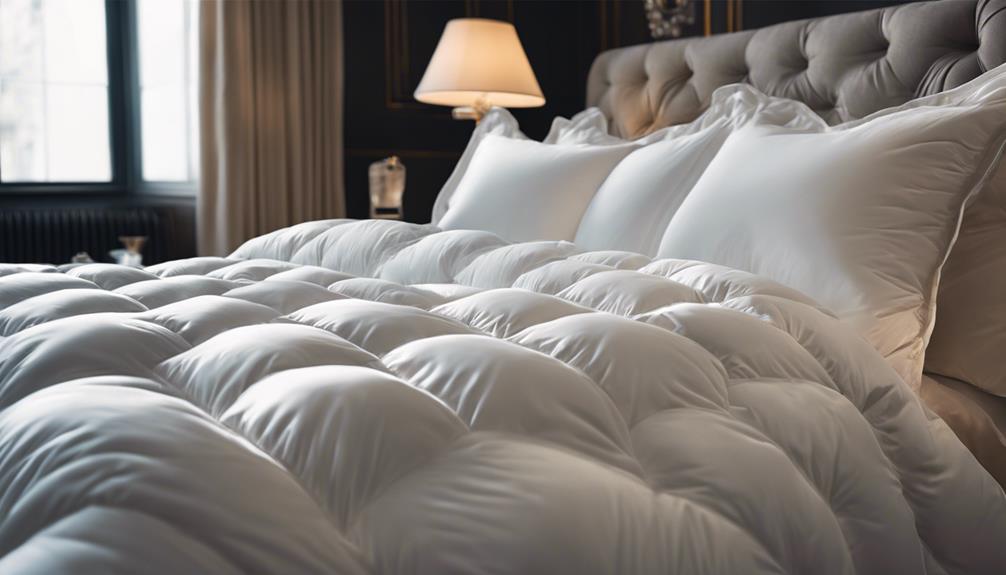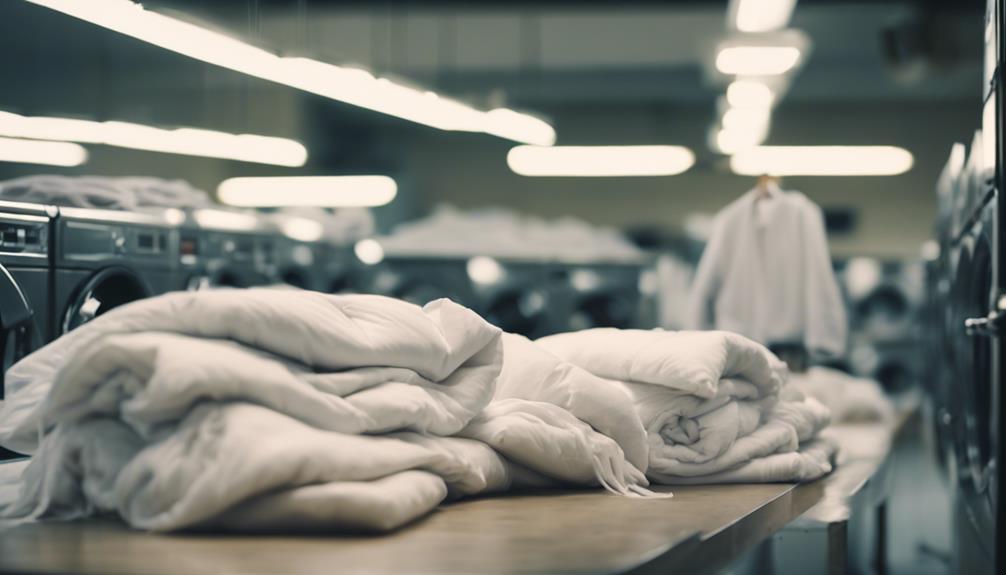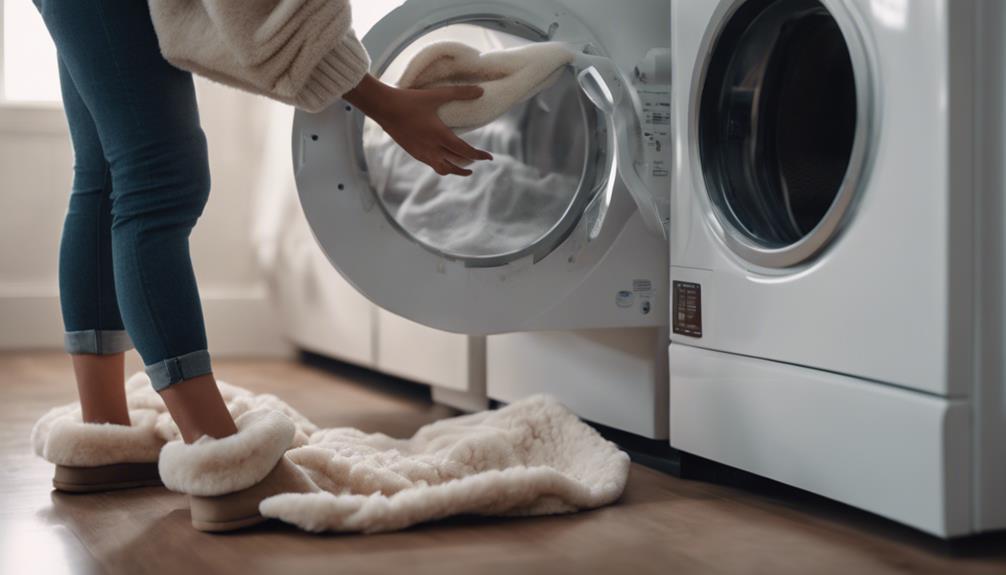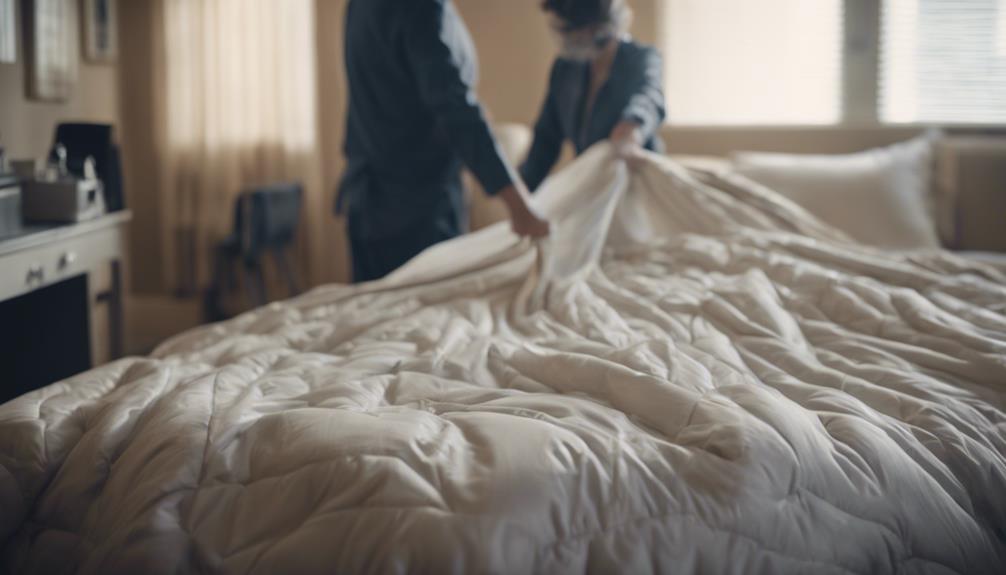Between 7 to 10 months of age is an ideal time to introduce a comforter to infants. This suggestion aligns with safe sleep practices and the stage when babies begin forming attachments to objects for comfort. It is crucial to prioritize safe sleep habits and establish positive associations with the comfort item to enhance security and reduce potential risks. The comforter should be safe and suitable for the child’s age, providing a cozy and secure environment. When contemplating introducing a comforter, consider your baby’s unique readiness and safety requirements. Further information is available regarding the advantages and safety measures of introducing comforters.
Key Takeaways
- Introduce comforter around 7-10 months.
- Wait for developmental readiness.
- Prioritize safe sleep practices.
- Create positive associations with comfort object.
- Opt for breathable, lightweight materials.
Recommended Age for Introducing Comforter

When introducing a comforter to babies, it's important to wait until they're between 9 and 12 months old. This age range aligns with safe sleep guidelines and the developmental stage when babies begin to form attachments to objects for comfort.
By waiting until this period, parents can make sure that the baby is developmentally ready to understand the purpose of a comfort object and less likely to experience any safety risks associated with items in the sleep environment. It's vital to prioritize safe sleep practices, including placing babies on their backs to sleep and keeping the sleep space free of loose bedding or toys until the recommended age.
Introducing a comforter at around 9 to 12 months old allows the baby to establish positive associations with the object, aiding in soothing and comfort during sleep times. Waiting until this stage also reduces the risk of the comforter posing a suffocation hazard or interfering with the baby's ability to self-soothe back to sleep.
Transitioning to Comforter Toy

Shifting to a comforter toy typically occurs around 9-12 months of age, following safe sleep guidelines and developmental readiness. When introducing a comfort item to babies and toddlers, it's fundamental to guarantee supervised sleep to promote a strong attachment while maintaining safety standards.
- Safe Sleep Practices: Always adhere to safe sleep guidelines, such as avoiding loose items in the crib for babies under 6 months of age.
- Developmental Readiness: Wait until your baby shows interest in a comforter toy around 9 months old before introducing it to their sleep routine.
- Initial Association: Consider using a muslin square initially to create a positive association with feeding before shifting to specific comforter toys.
- Comforter Characteristics: Opt for breathable and lightweight comforters to ensure safety, especially if introducing them early in your baby's development.
Individual Baby's Comforter Readiness

Introducing a comforter to a baby is typically recommended around 7 to 10 months of age, considering their emerging need for reassurance and comfort. Every little one is different, so the time to introduce a comforter may vary based on their individual readiness. While some babies may show interest in a comforter earlier, others might take a bit longer to form attachments. It's crucial to make sure that the comforter is safe for babies, with no small parts that could pose a choking hazard.
As babies grow, they may start experiencing separation anxiety, making a comforter a valuable source of comfort during times of distress. Around 7 months of age, it's generally safe to leave a comforter unattended in the cot, but always verify it's age-appropriate and free from potential risks. Understanding your baby's cues and responses can help determine when they're ready for a comforter, providing them with a source of security and familiarity.
Ensuring Safety of Comforter

To guarantee the safety of a comforter for infants, it's crucial to avoid loose items in the crib for those under 6 months old to minimize suffocation risks. When considering the safety of a baby's comforter, it's essential to create a conducive environment for safe sleep. Here are some important points to keep in mind:
- Opt for a breathable and lightweight comforter: Make sure that the material of the comforter allows for proper airflow to reduce the risk of overheating during sleep.
- Avoid comforter toys with small parts: To prevent choking hazards, choose a comforter that doesn't have small detachable parts that could be ingested by the baby.
- Consider using alternatives like muslin squares: Initially, opt for simpler options like muslin squares to introduce the concept of comfort without potential safety risks.
- Wait to introduce specific comforter toys: It's advisable to wait until the baby is older before introducing comforter toys that might pose safety concerns during sleep.
Tips for Introducing Comforter

When considering the safety of a baby's comforter, we must also focus on how to effectively introduce it to the infant around 7-9 months of age. Introducing a comforter to babies at this stage can provide them with a sense of reassurance and comfort, especially during bedtime and supervised sleep. To help familiarize babies with the comforter, incorporate it into their playtime and bedtime routines. One way to make the comforter more familiar is by having parents sleep with it to transfer their scent onto the item. During feeding times and playtime activities, encourage the baby to interact with the comforter, creating positive associations with it. Below is a table summarizing key tips for introducing a comforter to babies:
| Tips for Introducing Comforter |
|---|
| Introduce around 7-9 months |
| Familiarize during playtime and bedtime routines |
| Make it smell familiar by having parents sleep with it |
| Use during supervised sleep before 7-12 months |
Frequently Asked Questions
What Age Is It Safe to Use a Comforter?
It's safe to introduce a comforter to babies around 7-9 months when they seek reassurance. Red Nose advises against soft toys in the cot for infants under 7 months.
SIDS guidelines recommend waiting until the baby is 6 months old before introducing toys in the cot. Attachment to comforters usually begins between 9-12 months.
When introducing comforters, opt for ones resembling blankets or cloths for safety.
When Can I Introduce a Comforter to My Baby?
When introducing a comforter to your baby, we recommend around 7-9 months of age. At this stage, babies often seek reassurance and comfort, making it an ideal time for a comforter.
It's generally safe to leave a comforter unattended in the crib by 7 months. Starting earlier than 6 months may not yield significant benefits.
Don't worry if your baby doesn't immediately engage with a comforter; some babies show interest later on.
Can My 2 Year Old Sleep With a Comforter?
Yes, a 2-year-old can sleep with a comforter under supervision. Make sure the comforter is safe, age-appropriate, and free of choking hazards.
Many children develop a strong attachment to their comforter by this age.
It's crucial to monitor your child while using a comforter to prevent any risks during sleep.
Refer to pediatric guidelines for safe sleep practices with comforters to guarantee a safe and comfortable sleeping environment for your child.
Why Are Comforters Good or Bad for Toddlers?
Comforters can be beneficial for toddlers as they provide emotional support and comfort. They aid in self-soothing and managing emotions, especially during times of separation anxiety.
Introducing a comforter around 7-9 months can support a child's need for reassurance. Attachment to a comforter doesn't indicate insecurity in toddlers; rather, it can help them feel secure.
It's important to choose a safe and age-appropriate comforter for your child's well-being.
Can Using Polyester Comforters at a Young Age Be Harmful?
Using polyester comforters at a young age may pose potential health risks. The chemicals and toxins found in polyester comforters can lead to respiratory problems, skin irritation, and allergic reactions in children. It’s important to consider natural and non-toxic bedding options for children’s health and well-being.
Conclusion
To sum up, introducing a comforter to your baby at the right age can be like giving them a warm hug of security and comfort.
By following the recommended guidelines and ensuring safety measures, you can help your little one shift smoothly to using a comforter.
Remember, every baby is different, so pay attention to your child's readiness and comfort level.
With patience and care, your baby will soon form a special bond with their comforting companion.










